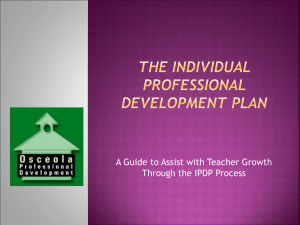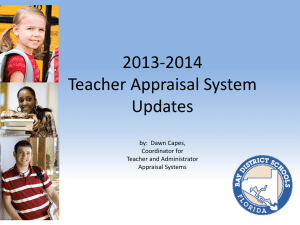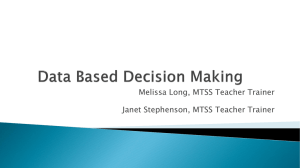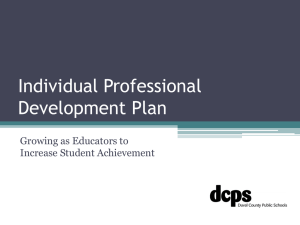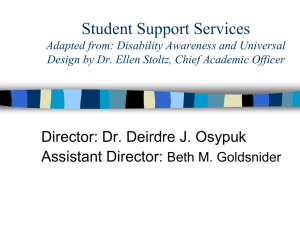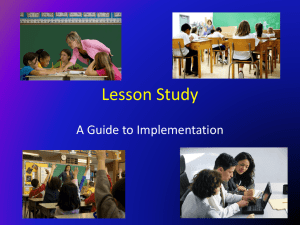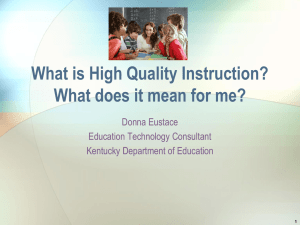Example - Bay District Schools
advertisement
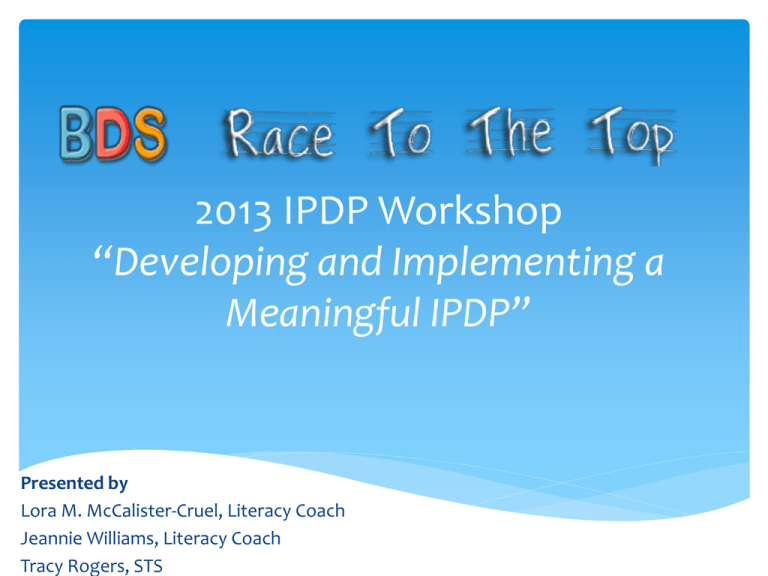
2013 IPDP Workshop “Developing and Implementing a Meaningful IPDP” Presented by Lora M. McCalister-Cruel, Literacy Coach Jeannie Williams, Literacy Coach Tracy Rogers, STS EQ & Lesson Purpose EQ: How can you develop a meaningful IPDP for increased student achievement and increased professional growth? Lesson Purpose: To review ‘13-14’ IPDP Modifications, learn how to develop a meaningful IPDP and learn how IPDPs are scored. Learning Targets You will be able to: • Explain the purpose of the IPDP Process • Explain the updates to 13-14 BDS IPDP Evaluation • Explain the steps for developing an IPDP • Explain the use of the IPDP rubric in scoring SB 1664 School Community Professional Development Act (FSS 1012.98) The individual professional development plan must: a. Be related to specific performance data for the students to whom the teacher is assigned. b. Define the in-service objectives and specific measurable improvements expected in student performance as a result of the in-service activity. c. Include an evaluation component that determines the effectiveness of the professional development plan. IPDP CYCLE Identify student weaknesses Hypothesis Reflect on the impact of the strategy or practice Strategy or practice to impact weakness Progress monitor the strategy or practice Learn about the strategy How much impact Implement the strategy or practice Step 1 Step 2 Step 3 All instructional personnel should review and understand the following for each content subject area addressed on their School Improvement Plan: • • • • • Current school-wide data Trend school-wide data Goals (including strategies and barriers) Professional development offerings Identify the SIP goal that best aligns to your impact area (Math, Reading, Social Studies, Science, Writing) All instructional personnel should review and understand classroom level data (including student and teacher data) by reviewing and understanding: • • • • Previous IPDP/Evaluations Teacher Self-Assessment Classroom or impact area trend data Current student classroom or impact area data All instructional personnel should focus their professional growth plan efforts on a targeted group and the individuals within the targeted group by: • • • • Using essential questions to facilitate data analysis Compiling multiple sources of student data related to IPDP focus Identifying patterns, trends, strengths, weaknesses Identifying an applicable instructional strategy or practice to study • Is there an achievement gap in reading, math or science among different groups of students? Is the gap growing larger, smaller or staying the same? • Are male students performing better than female students? Why and how will we increase the performance of female students? • What are the characteristics of my students who achieve proficiency and of those who do not? • Are there more poor or minority students in special education classes than there are in advanced placement classes? • To what extent have specific programs, interventions, and services improved outcomes? Compile data that is pertinent to the content area and impact group which directly relates to your IPDP focus. Data sources could be compiled in various ways: • • • • Student only Combination of student, parents, teachers Combination of student, teachers, administrators Combination of student, program/intervention, teachers The Self-Assessment must be included. Teacher: K– 3 and Special Areas IPDP focus: Math, reading, science, or writing Possible Data Sources: • • • • • • • • SME DEA AP1 Learning Styles Observational Records Publisher Pre/Post Tests Fluency Records Writing Samples Technology Diagnostic • • • • • • • Dibles Deep DAR Surveys/Interviews (parents/ students) Anecdotal Records Interest Inventories IEPs MTSS Intervention Plans Teacher: 4th-5th and Special Areas IPDP focus: Math, reading, science or writing Possible Data Sources: • • • • • • • • • SME DEA AP1 FCAT 2.0 Learning Styles Observational Records Publisher Pre/Post Tests Fluency Records Writing Samples Technology Diagnostic • • • • • • • • Dibles Deep DAR Surveys/Interviews (parents/ students) Anecdotal Records Interest Inventories IEPs Special Area Specific Diagnostic MTSS Intervention Plans Teacher: 6th-8th and Electives IPDP focus: Math, reading, science, civics, writing Possible Data Sources: • • • • • • • • SME DEA AP1 FCAT 2.0 Learning Styles Observational Records Publisher Pre/Post Tests Fluency Records Writing Samples • • • • • • • • EOCs DIBELS Deep DAR Surveys/Interviews (parents/ students) Technology Diagnostic Interest Inventories IEPs MTSS Intervention Plans Teacher: 9th-12th and Electives IPDP focus: Math, reading, science, social studies, writing Possible Data Sources: • • • • • • • • SME DEA AP1 FCAT 2.0 Learning Styles Observational Records Publisher Pre/Post Tests Fluency Records Writing Samples • • • • • • • • EOCs AP/DE DAR Surveys/Interviews (parents/ students) Technology Diagnostic Interest Inventories IEPs MTSS Intervention Plans Instructional Personnel: Literacy Coach, Staff Training Specialists IPDP focus: Math, reading, science, civics, writing Impact Area: Job-Embedded Professional Development Possible Data Sources: Student Data • DEA AP1 • FCAT 2.0 • Writing Diagnostic • Fluency Records • Observational Records • Publisher Pre/Post Tests • Surveys/Interviews (parents/ students) • Technology Diagnostic Personnel Data • Teacher PD Survey • Admin PD Survey • Observational Records (classroom, meeting facilitation) • IEPs audits • MTSS Intervention Plans Instructional Personnel: Social/Mental Health IPDP focus: Math, reading, science, civics, writing Impact Area: MTSS Intervention Program Possible Data Sources: Student Data • DEA AP1 • FCAT 2.0 • Writing Samples • Fluency Records • Observational Records • Publisher Pre/Post Tests • Surveys/Interviews (parents/ students) • Technology Diagnostic Personnel Data • Teacher PD Survey • Admin PD Survey • Observational Records (classroom, meeting facilitation) • IEPs audits • MTSS Intervention Plans Instructional Personnel: ESE Resource Teacher IPDP focus: Math, reading, science, civics, writing Impact Area: IEP Implementation Possible Data Sources: Student Data • DEA AP1 • FCAT 2.0 • Writing Samples • Fluency Records • Observational Records • Publisher Pre/Post Tests • Surveys/Interviews (parents/ students) • Technology Diagnostic Personnel Data • Teacher PD Survey • Admin PD Survey • Observational Records (classroom, meeting facilitation) • IEPs • MTSS Intervention Plans Disaggregating - Analyzing data by specific subgroups of students. Gender Socio-economic status (AYP Subgroup) Race and ethnicity (AYP Subgroup) Special education and disability (AYP Subgroup) English as a Second Language (ESL) (AYP Subgroup) Proficiency Levels (Achievement Levels) Teachers (as subgroup) *Mobility (students moving in and out of the districts at any given time) Enrollment patterns in courses like physics or algebra Successful completion of specific course such as advanced placement Triangulation - Use 3 sources of data to illuminate, confirm, or dispute what you learned from an initial analysis of one piece of data. Self Portrait Sept. 15, 2006 Self Portrait Sept. 22, 2006 9 of the 22 (41%) students are below proficiency on 2012 FCAT 2.0 Reading 7 of the 9 (78%) students are below proficiency on DEA AP1 Reading 7 of the 9 (78%) students are disfluent on Maze 12 of the 20 (60%) Tier II students (9 teachers) are level 1 on DEA AP1 Math 4 out of the 9 (44%) teachers report “some confidence” in providing interventions for their students 8 of the 12 (67%) students below proficiency on DEA AP1 Math were receiving interventions that their current schools do not have access to (6 teachers out of 9 67%) Data Analysis Supporting Documentation - Write a summary that includes all the steps that led you to your findings. *This will be uploaded in AIMS. Baseline Data Statement – Statement which identifies the disaggregation for the targeted group, the triangulation of data, and individuals within the group as well as their specific weakness. Needs-Based Question for Classroom Teachers Needs-based question – A question of inquiry on a specific instructional/professional strategy or practice that drives the action research process and visibly relates to student needs (data) offering a point for reflection for professional growth. Example Will using Webb’s Depth of Knowledge formatted questioning during instruction, discussion, and assessments increase my students’ achievement in moderate complexity questions in the reading application category? (STRATEGY) Example Will using CRISS strategy of selective highlighting increase students’ achievement in identifying causes and effects? (STRATEGY) Needs-Based Question for Other Instructional Personnel Needs-based question – A question of inquiry on a specific instructional/professional strategy or practice that drives the action research process and visibly relates to student needs (data) offering a point for reflection for professional growth. Example Will modeling weekly lessons on using graphic organizers for complex text increase teachers’ use of graphic organizers during instruction with students for informational text? (PRACTICE) Example Will conducting professional development on observational/anecdotal records increase data collection of teachers providing MTSS interventions and improving student behavior? (PRACTICE) Expected Student Achievement Goal for Classroom Teachers Expected Student Achievement Goal – A specific, measurable, attainable, reasonable, and timely statement that indicates expected growth of students based on the relationship between the implemented instructional strategy or practice. Example 5 out of 10 (50% )of my targeted students will earn 100% on the moderate complexity questions in all reporting categories on DEA Reading AP3. Example 4 out of 5 (90%) of my students will meet proficiency (level 3) on DEA AP2 Science in the Nature of Science reporting category. Expected Student Achievement Goal for Other Instructional Personnel Expected Student Achievement Goal – A specific, measurable, attainable, reasonable, and timely statement that indicates expected growth of students based on the relationship between the implemented instructional strategy or practice. Example 10 out of 10 (100% )of my targeted teachers will participate in 3 out of 3 (100%) lesson study cycles focusing on using graphic organizers with complex text by March 2014. Example 8 out of 12 (67%) targeted teachers will increase their knowledge of documentation by participating in at least 3 out of 5 (60%) professional development trainings for observational/anecdotal records by February 2014. Related Professional Development Objectives for Classroom Teachers Related Professional Development Objectives – A series of research-based professional development activities aligned to the expected student achievement goal and instructional personnel self-assessment that is needed to enhance or develop instructional strategies and practices. Example Based on my self-assessment to develop my skills in planning and delivering coherent instruction and my targeted groups’ weakness in moderate complexity questions: • I will need to enhance my knowledge of Webb’s DOK • I will need to develop my skill in developing Essential Questions for daily lessons • I will need to enhance my skills in planning for Think-Aloud strategy using complex text Related Professional Development Objectives for Other Instructional Personnel Related Professional Development Objectives – A series of research-based professional development activities aligned to the expected student achievement goal and instructional personnel self-assessment that is needed to enhance or develop instructional strategies and practices. Example Based on my self-assessment to develop my skills in providing professional development to adult learners: • I will need to develop my knowledge of facilitating vs presenting • I will need to enhance my skills in using technology for presentations • I will need to develop my skill in collecting observational data Related Professional Development Activities Related Professional Training and Learning Activities – Diverse formats of research-based professional development and participation. Objectives: I will review Educational Impact video to enhance my knowledge of Webb’s DOK (Notes and Calendar). • Webb’s DOK • Think-Aloud for complex text • Essential Questions for daily lessons I will observe Literacy Coach model think-aloud strategy using complex text (Video and Reflection). I will participate in Lesson Study activities for my subject area focusing on developing Essential Questions for lessons and units (Lesson Plans and Reflection Statements). Related Professional Development Activities for Other Instructional Personnel Related Professional Training and Learning Activities – Diverse formats of research-based professional development and participation. Objectives: • Facilitating Adult Learning • Technology for Presentations • Observational Record Keeping I will attend Florida Reading Association Conference to enhance my knowledge of Facilitating for Adult Learning (Notes, Agendas). I will observe Technology TOSA model lesson on technology for presentations. (AIMS and eflection statements). I will review Clinical Educator Training on the collection methods of verbatim and selective verbatim. (Data Collection Forms) Classroom Implementation Classroom Implementation – The application of the instructional strategy/practice in conjunction with comprehensive and significant documentation, including, but not limited to an accurate and perceptive reflection as an on-going process. Develop IPDP Implementation Calendar to include the following: IPDP Timeline Dates for Attending/Reviewing Professional Development Dates for Strategy/Practice Delivery (Lesson Plans) Dates to Collect Sample Sets Student Progress Monitoring (Needed for Mid-course Corrections) Dates of Benchmark Assessments Other Dates (Feedback sessions with Peers, admins, etc.) Classroom Implementation Pre-implementation statements… I will participate in Lesson Study Cycle for student-generated higher order questioning from August -October Conduct lesson on WEBB’s DOK to students in September I will participate in Webinar from Educational Impact on Webb’s DOK – in September I will observe Literacy Coach model a lesson on student-generated questions in October I will collect sample sets in October and December I will administer benchmark assessment in December Developing a Meaningful IPDP Activity • Use the mock data you are assigned • You will only need to write the following: • • • • • • Baseline Data Statement Needs-based Question Expected Student Achievement Goal Related Professional Development Objectives Related Professional Development Training and Activities Classroom Implementation IPDP Scoring Activity • Each group will be assigned an IPDP to review with the rubric • Each group will score each section and then present to the group for feedback Contact Us Dawn Capes, Coordinator of Teacher and Administrator Appraisal Systems capesda@bay.k12.fl.us @DawnCapes1 Lora M. McCalister-Cruel, Literacy Coach mccallm@bay.k12.fl.us @McCalisterCruel Jeannie P. Williams, Literacy Coach willijp@bay.k12.fl.us
